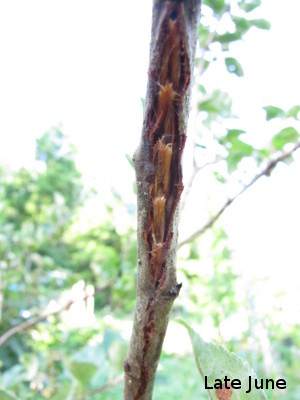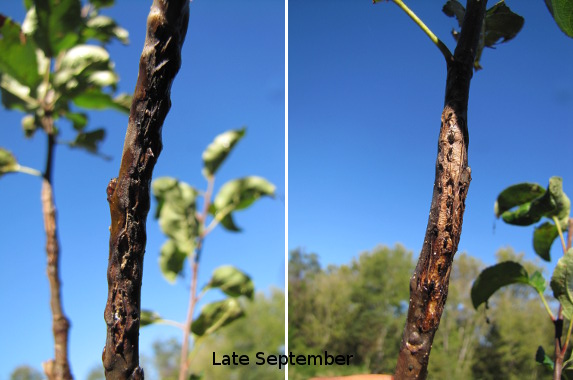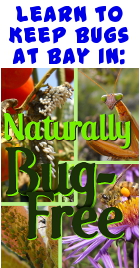
Preventing cicada damage to fruit trees
 This has been a tough year
for our fruit trees. The waves of sound from the periodic
cicadas made us feel
like we were enjoying a spring by the seashore, and the chickens loved
the high protein snacks. But as the insects' reign came to an
end, the female cicadas laid eggs in tender twigs of blueberries,
apples, pears, and peaches. Many young limbs simply perished from
the onslaught, and everyone was set back.
This has been a tough year
for our fruit trees. The waves of sound from the periodic
cicadas made us feel
like we were enjoying a spring by the seashore, and the chickens loved
the high protein snacks. But as the insects' reign came to an
end, the female cicadas laid eggs in tender twigs of blueberries,
apples, pears, and peaches. Many young limbs simply perished from
the onslaught, and everyone was set back.
Although I didn't think
it was lucky at the time, we were fortunate to have a late frost that
wiped out many of the trees' fruits. It's possible that if our
trees had been weighed down with peaches and pears, they might have
been less able to overcome the cicadas' attacks, so the frost may have
done us a favor in the long run. As it was, I suspect we came out
about even --- the trees didn't have to expend energy setting fruits,
so they were able to take the time to heal.

 Luckily, periodic cicadas
only come around every 13 or 17 years, and since cicadas prefer young
trees, we might be out of the woods by the next emergence date.
Experts also suggest marking your calendar with the possible years you
may see periodic cicadas, then delaying winter pruning until the
cicadas are gone so you can deal with damage without taking away too
much young wood. (You can look up emergence
dates for your area here, but the site didn't have
information about our local population this year, so take the
information with a grain of salt.)
Luckily, periodic cicadas
only come around every 13 or 17 years, and since cicadas prefer young
trees, we might be out of the woods by the next emergence date.
Experts also suggest marking your calendar with the possible years you
may see periodic cicadas, then delaying winter pruning until the
cicadas are gone so you can deal with damage without taking away too
much young wood. (You can look up emergence
dates for your area here, but the site didn't have
information about our local population this year, so take the
information with a grain of salt.)
If you're not quite
together enough to plan your cicada management 17 years in advance, you
can put netting around twigs less than half an inch in diameter as soon
as you hear the periodic cicadas beginning to call. There are
also plenty of chemical solutions, but I'd rather lose twigs every
decade or so than wipe out my beneficial insects.
What have you done to
deal with damage from periodic cicadas on young fruit trees?
 This post is part of our 2012 Forest Garden lunchtime series.
Read all of the entries: This post is part of our 2012 Forest Garden lunchtime series.
Read all of the entries: |
Want more in-depth information? Browse through our books.
Or explore more posts by date or by subject.
About us: Anna Hess and Mark Hamilton spent over a decade living self-sufficiently in the mountains of Virginia before moving north to start over from scratch in the foothills of Ohio. They've experimented with permaculture, no-till gardening, trailersteading, home-based microbusinesses and much more, writing about their adventures in both blogs and books.
Want to be notified when new comments are posted on this page? Click on the RSS button after you add a comment to subscribe to the comment feed, or simply check the box beside "email replies to me" while writing your comment.
